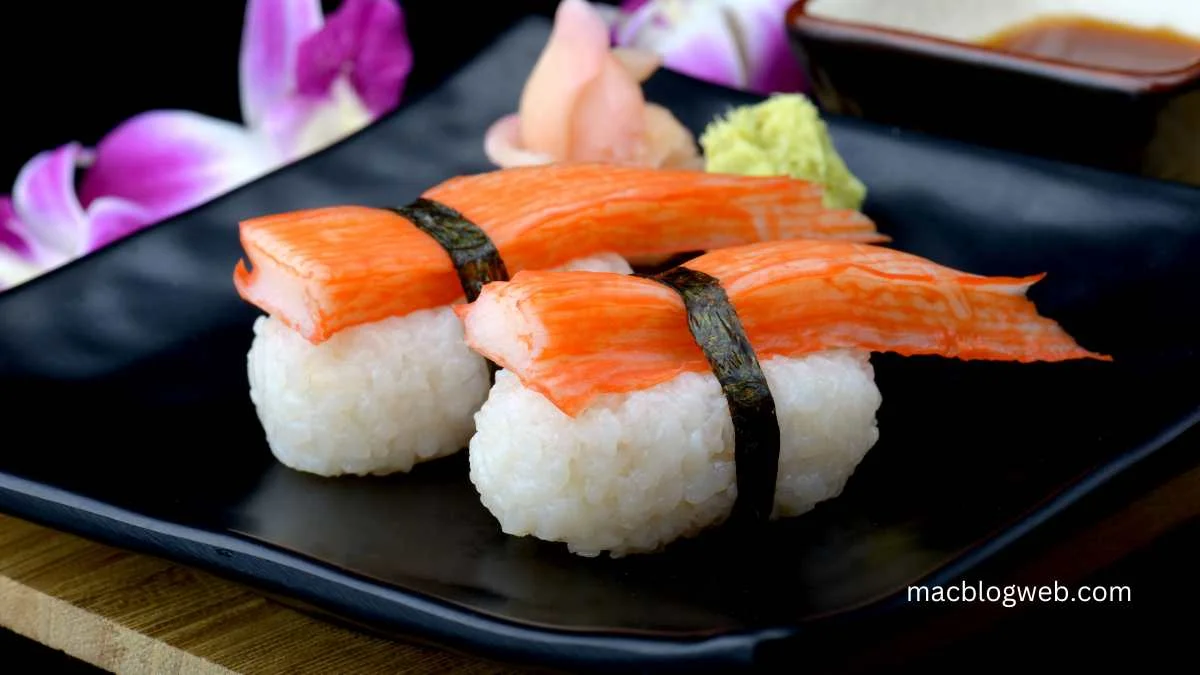Kani sushi, a delightful combination of imitation crab meat and traditional sushi elements, is a lesser-known yet fascinating aspect of Japanese cuisine. Despite its less illustrious reputation compared to other types of sushi, Kani sushi offers a unique blend of flavors and textures that appeal to both sushi novices and aficionados. This comprehensive article delves into the origins, ingredients, preparation methods, nutritional benefits, and cultural significance of Kani sushi.
What is Kani Sushi?
Understanding “Kani”
The term “Kani” is Japanese for “crab,” but in the context of Kani sushi, it typically refers to imitation crab meat. Imitation crab, also known as “surimi,” is crafted from white fish such as pollock. The fish is processed and mixed with starch and other ingredients to mimic the texture, flavor, and appearance of real crab meat. Occasionally, Kani can also refer to lobster or shrimp, but the imitation version is most common in Kani sushi.
Kani Sushi Explained
Kani sushi combines imitation crab meat with traditional sushi elements. The most popular form is the spicy Kani maki roll, which features cooked crab meat, vinegared rice, and seaweed (nori). The crab meat can be shredded or shaped into sticks and is often spiced to enhance its flavor. Kani sushi is a versatile dish, served as an appetizer or a main course, and appreciated for its simplicity and delicious taste.
Historical Context
The Origins of Sushi
Sushi originated in Southeast Asia as a method of preserving fish in fermented rice. This technique spread to Japan, where it evolved into the sushi we know today, characterized by vinegared rice combined with various ingredients. The word “sushi” refers to the vinegar-flavored rice, rather than the toppings or fillings.
Evolution of Kani Sushi
The concept of using imitation crab meat in sushi emerged as a practical and cost-effective alternative to real crab. Surimi, the base for imitation crab, was invented in Japan in the early 20th century but gained widespread popularity in the 1970s and 1980s. This period saw a surge in creative sushi variations, leading to the creation of Kani sushi, which incorporated the accessible and versatile imitation crab.
Ingredients and Preparation
Key Ingredients
- Imitation Crab (Kani): Made from white fish like pollock, surimi is processed to imitate crab meat’s texture and flavor.
- Sushi Rice: Short-grain rice seasoned with rice vinegar, sugar, and salt.
- Nori (Seaweed): Dried seaweed sheets used to wrap the sushi roll.
- Spices: Often includes mayonnaise mixed with sriracha or other spicy condiments to create a spicy Kani mix.
- Vegetables: Common additions include cucumber, avocado, and sometimes thinly sliced radish.
Preparation Steps
- Cooking the Rice: Sushi rice is cooked and seasoned with a mixture of rice vinegar, sugar, and salt to achieve the distinctive vinegared flavor.
- Preparing the Kani: Imitation crab meat is either shredded or cut into sticks. For spicy Kani rolls, the crab is mixed with a spicy mayonnaise sauce.
- Assembling the Roll: A bamboo mat (makisu) is typically used. A sheet of nori is placed on the mat, covered with an even layer of sushi rice. The Kani and other fillings (like cucumber and avocado) are placed in the center.
- Rolling: The mat is used to roll the sushi tightly, ensuring the fillings are secured within the rice and nori.
- Cutting and Serving: The roll is sliced into bite-sized pieces and often garnished with additional spicy mayo, sesame seeds, or tobiko (fish roe).
Nutritional Benefits
Kani sushi is not only tasty but also offers various nutritional benefits:
- Protein: The imitation crab provides a good source of protein, essential for muscle repair and growth.
- Omega-3 Fatty Acids: While imitation crab contains fewer omega-3s than real crab, it still offers some heart-healthy fats.
- Vitamins and Minerals: Sushi rice and nori contribute vitamins B12 and A, as well as minerals like iodine, which is crucial for thyroid health.
- Low Calorie: Kani sushi is relatively low in calories, making it a healthy option for those mindful of their caloric intake.
Cultural Significance
Sushi in Japanese Cuisine
Sushi holds a revered place in Japanese cuisine, symbolizing a blend of tradition and innovation. It is not merely food but an art form, with sushi chefs undergoing rigorous training to master the delicate techniques required.
Kani Sushi’s Role
While not as traditional as nigiri or sashimi, Kani sushi reflects the adaptability and creativity within Japanese culinary arts. It represents how modern ingredients and methods can coexist with traditional practices to create something new and exciting.
Popular Variations
Spicy Kani Roll
The spicy Kani roll is the most common variation, featuring imitation crab mixed with spicy mayo, wrapped in sushi rice and nori. It is often garnished with additional spicy sauce, sesame seeds, or fish roe.
Kani Nigiri
Kani nigiri consists of a small ball of sushi rice topped with a piece of imitation crab, sometimes bound with a thin strip of nori. It’s a simpler presentation that highlights the flavor of the crab.
Kani Salad
A deconstructed version of Kani sushi, the Kani salad features shredded imitation crab mixed with cucumber, avocado, and spicy mayo, often served on a bed of sushi rice or lettuce.
Making Kani Sushi at Home
Tools Needed
- Bamboo Mat (Makisu): For rolling the sushi.
- Sharp Knife: Essential for cleanly slicing the sushi roll.
- Rice Cooker: To perfectly cook sushi rice.
- Mixing Bowls: For preparing the Kani mixture and seasoning the rice.
Step-by-Step Guide
- Cook the Rice: Use a rice cooker to prepare the sushi rice, then mix it with the rice vinegar seasoning while it’s still warm.
- Prepare the Kani: Shred the imitation crab and mix with spicy mayo if making a spicy roll.
- Lay Out the Ingredients: Place a sheet of nori on the bamboo mat, shiny side down. Spread an even layer of rice over the nori, leaving a small margin at the top.
- Add Fillings: Place the Kani and any additional fillings (cucumber, avocado) in a line along the bottom edge of the rice-covered nori.
- Roll the Sushi: Use the bamboo mat to roll the sushi tightly, pressing gently to keep the roll firm.
- Slice and Serve: Cut the roll into bite-sized pieces with a sharp knife, wiping the blade clean between cuts to ensure smooth slices. Serve with soy sauce, pickled ginger, and wasabi.
Dining Experience and Serving Suggestions
Presentation
Presentation is a key element in Japanese cuisine. Arrange the sushi pieces neatly on a plate, garnished with a dollop of spicy mayo, sesame seeds, or a sprinkling of fish roe. Accompany with small bowls of soy sauce, pickled ginger, and wasabi for dipping and palate cleansing.
Pairing
Kani sushi pairs well with light and refreshing beverages such as green tea, sake, or a crisp white wine. These drinks complement the delicate flavors of the sushi without overpowering them.
Occasions
Kani sushi is versatile enough to be served at various occasions, from casual lunches to more formal dinners. Its light and fresh taste make it suitable for warm weather meals, but it can be enjoyed year-round.
Kani Sushi in Popular Culture
Global Popularity
Kani sushi, like many other sushi types, has moved beyond its Japanese roots to become a beloved dish around the world. It’s a staple in sushi restaurants everywhere and can often be found in supermarket sushi sections, making it easily accessible to a broad audience.
Media and Entertainment
Sushi, including Kani sushi, frequently appears in media and entertainment, symbolizing Japanese culture and cuisine. It is often depicted in cooking shows, food blogs, and travel documentaries, highlighting its appeal and versatility.
Health Considerations
Imitation Crab vs. Real Crab
While imitation crab is a convenient and affordable alternative to real crab, it is important to note some differences. Imitation crab is lower in certain nutrients, such as omega-3 fatty acids and real crab’s mineral content. It also often contains added starches and sugars, which can affect its nutritional profile.
Allergens
Imitation crab contains fish and sometimes other allergens like wheat or egg, depending on the brand. It is important for individuals with food allergies to check the ingredient list carefully.
Sodium Content
Imitation crab can be high in sodium, so it is advisable for individuals watching their salt intake to consume Kani sushi in moderation or seek out lower-sodium versions.
Conclusion
Kani sushi, with its blend of imitation crab and traditional sushi elements, offers a delightful and accessible entry point into the world of sushi. Its history, preparation, nutritional benefits, and cultural significance make it a fascinating subject for culinary enthusiasts and casual diners alike. Whether enjoyed as a spicy Kani roll, a simple nigiri, or a refreshing Kani salad, this versatile dish continues to captivate palates around the globe. By understanding its ingredients, preparation methods, and cultural context, one can fully appreciate the nuanced flavors and textures that Kani sushi brings to the table.








